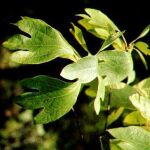

Leaf: Alternate, simple, pinnately veined, ovate to elliptical, entire, 3 to 6 inches long with 1 to 3 lobes. The 2-lobed leaf resembles a mitten, the 3-lobed leaf resembles a trident. Flower: Dioecious, green-yellow in color, borne in 2 inch racimes. Present March to April. Fruit: Dark blue, ovoid, fleshy drupes that are borne on red stalks. Maturing August to September. Twig: Slender, green and sometimes pubescent, with a spicy-sweet aroma when broken. Buds are 1/4 inch long and green. Bark: Brown, with cinnamon-brown inner bark, becoming coarsely, ridged and furrowed. When cut the spicy aroma is obvious. Form: Small to medium-sized tree with an irregular, usually flat-topped crown. Root suckering may result in thickets.
*This plant contains an ingredient known as safrole which is known to cause cancer in laboratory rats and is banned in the Unites States for distribution and usage; Also do not use this herb if pregnant because it can induce menstruation and labor |
|
poltices of crushed root can be applied to skin ailments and used externally. |
|
Essential Guide to Natural Home Remedies by Penelope Ody Copyright © 1977, 2002 by Penelope Ody pg.13 Rosemary Gladstar's Family Herbal by Rosemary Gladstar Copyright © 2001 by Rosemary Gladstar pg 163 Tom Brown's Guide to Wild Edible and Medicinal Plants by Tom Brown Jr Copyright © 1985 by Tom Brown pp181-184 Peterson Field Guides Edible Wild Plants by Lee Allen Peterson Copyright © 1977 by Lee Peterson pg 210 The Cherokee Herbal by J.T. Garrett Copyright © 2003 by J.T. Garrett pp 95,138, 187, 238 Dendrology at Virginia Tech |